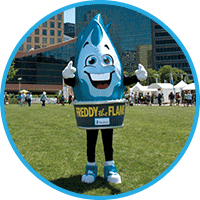Energy & Natural Gas FAQ
(frequently asked questions)
Have you ever wondered why natural gas flames are blue? Or who first discovered natural gas? Now you can get answers to these and all your natural gas-related questions.
We post new questions and answers regularly, so check back!
Click on a question below to see the answer:
Why does natural gas smell like rotten eggs?
Answer: In its natural state, natural gas has no odor. Utility companies add a chemical odorant called “mercaptan” to natural gas to help make gas leaks easier to notice. If you have a natural gas stove, you may have smelled this rotten egg odor when the pilot light has gone out.
Why is natural gas called “natural” gas?
Answer: Natural gas is called “natural” because when this type of gas was first discovered, it could be used directly from the ground in its natural state, without any processing. Today, gas utilities process natural gas by removing water, sand, and other compounds so that when the gas is delivered to your home it will burn as cleanly and efficiently as possible. And in its natural state gas has no odor, so that’s why companies add a harmless but stinky chemical to it; the odor helps people smell a leak that otherwise, in the gas’s natural state, doesn’t smell.
Are more homes heated by natural gas or electricity?
Answer: More homes in the U.S. are heated by natural gas than by electricity.
What are natural gas vehicles?
Answer: Vehicles that run on natural gas instead of gasoline are called natural gas vehicles (NGVs). There are about 112,000 NGVs on U.S. roads today and over 13 million worldwide. NGVs are a popular transportation choice because they run cleaner than other vehicles. Compared to gasoline- or diesel-powered vehicles, they produce much lower levels of pollutants and cost less to maintain. Also, natural gas costs, on average, one-third less than conventional gasoline at the pump.
Why does the flame on my stove burners look blue, but the flame of a campfire is yellow?
Answer: A natural gas flame burns hotter than a campfire. In general, cooler flames appear yellow, orange, or red, while hotter flames look blue or white. (Flecks of orange in your gas flames are OK, but if the flame is yellow, large, and flickering, the appliance may need a safety adjustment by a qualified repair person.)
Who discovered natural gas?
Answer: The ancient Chinese were the first to discover underground deposits of natural gas. In 600 BC, Confucius wrote of wells 100 feet deep yielding water and natural gas along the Tibetan border. The Chinese piped the gas to where it was needed through long, hollow bamboo tubes.
Did Native American people use natural gas?
Answer: Yes. In 1626, French explorers found Native Americans igniting gases that were seeping into and around Lake Erie.
How fast does natural gas move through pipelines?
Answer: Natural gas travels through pipelines at the slow and steady pace of 15 miles per hour.


